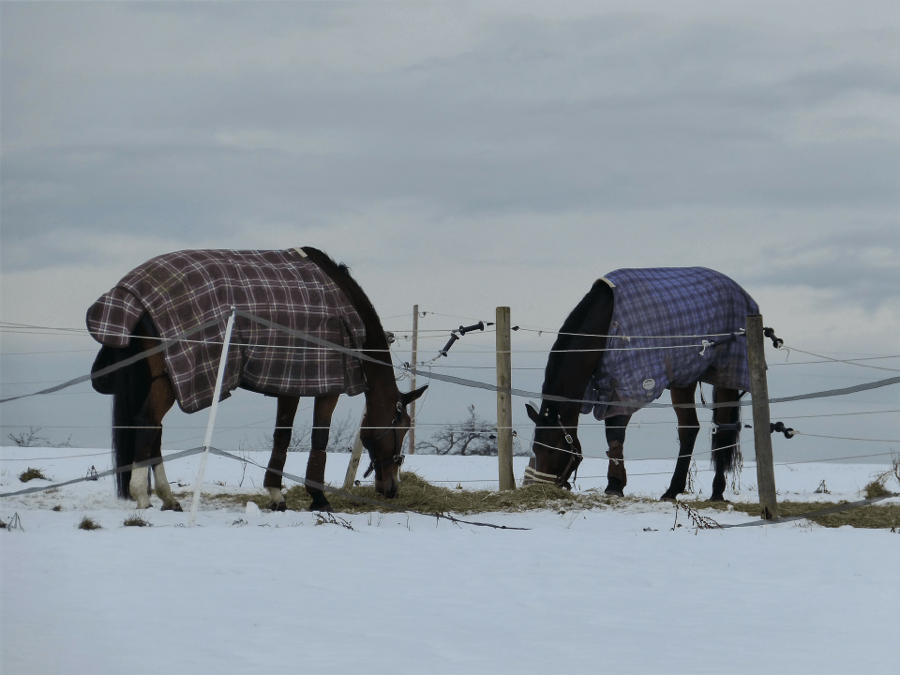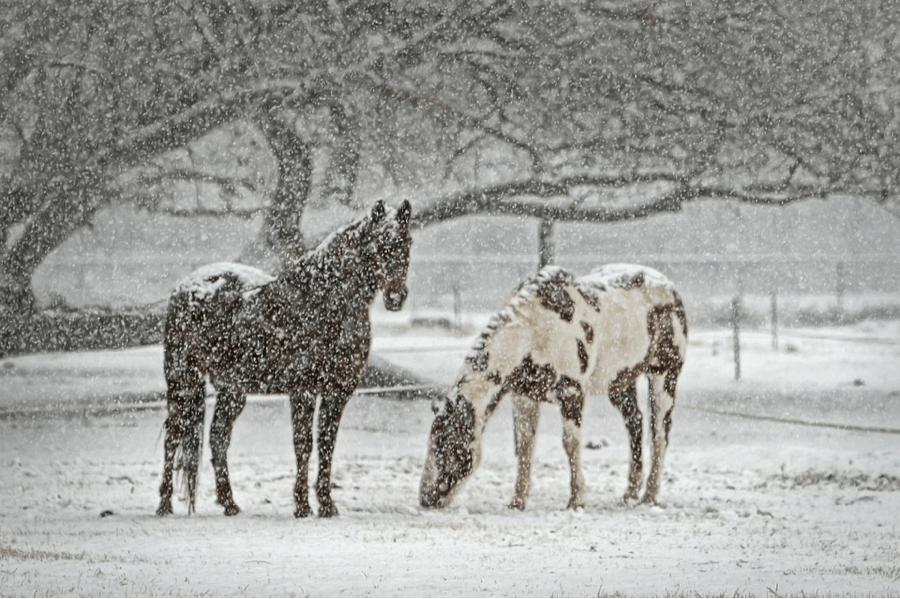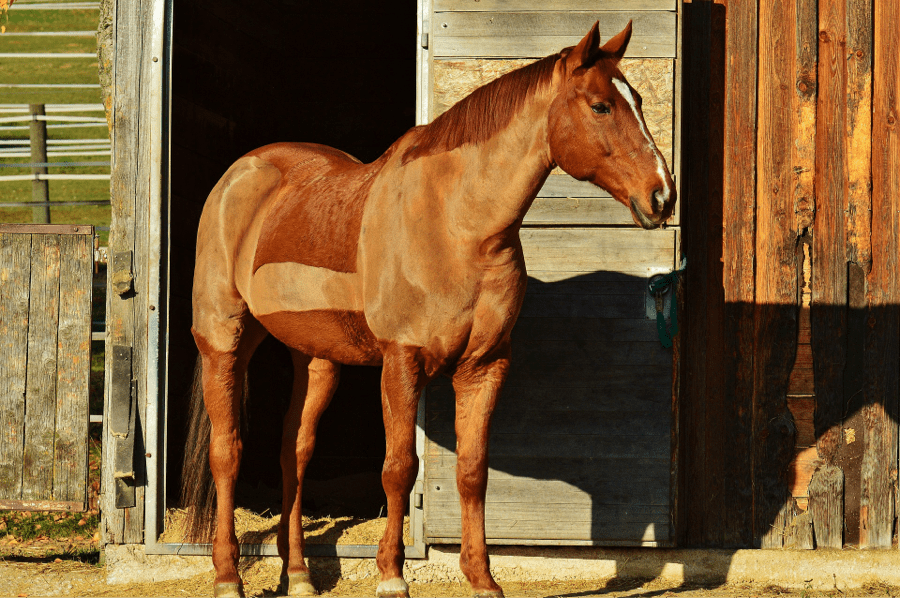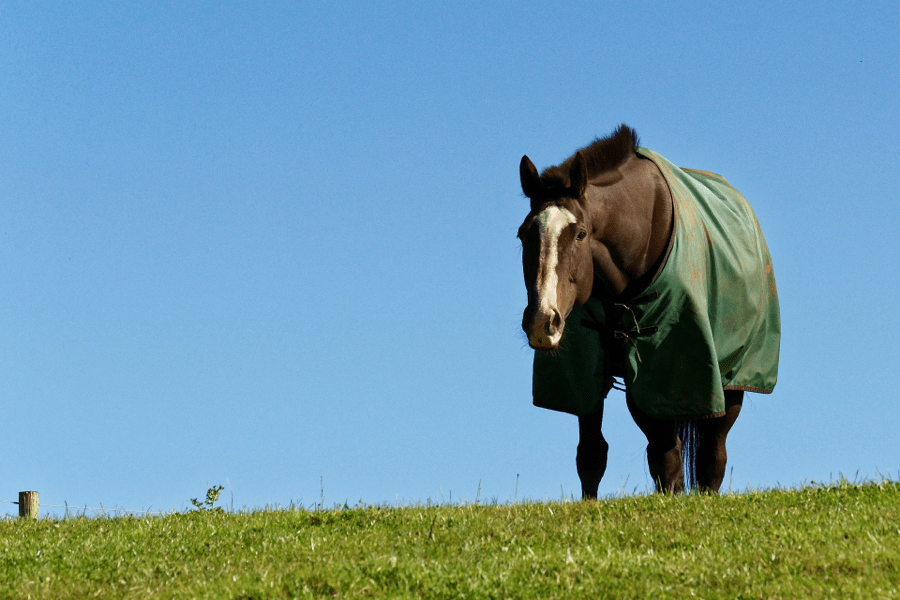Tuesday, December 5, 2017
L'winter is fast approaching and it's already cold... The horses are starting to put on their winter coatand riders are starting to ask questions. One of these questions is: what blanket should I put on my horse? Rest assured, this article will give you the answers you need.

In winterthe horse's coat is more thicker, longerand more waterproof to create a thermal insulation layer. This protects it from the coldfrom wind and rain. In nature, horses have been "designed" not to suffer from the cold and not to need a blanket. A horse that lives outdoors, doesn't work regularly and has good shelter in its pasture can spend the winter "naked". naked ". By living outdoors, the horse has gradually adapted to the temperature and produced hair accordingly.
"As a guide, the lower critical temperature - below which the horse must be helped to fight the cold (extra energy intake, protection, shelter) - varies: from -15°C for adults to 22°C for newborns, via 0°C for foals." - Dr. I. Mennecier (1)

An (uncoated) horse that lives in a stall will be more sensitive to temperature changes than a pasture horse. He'll need a blanket at night, for example. The temperature is obviously important: an unsheared horse won't necessarily need a blanket at 5°C. It will, however, need a warm blanket at -12°C. He will, however, need a warm blanket at -12°C. Each horse must be considered on its own merits. Some breeds are more hardy than others. In fact, not all horses produce the same hair thickness. They therefore do not have the same resistance to cold.
In some cases, for an old horse or in poor health it will be necessary to cover the horse. It is possible to limit the development of winter coat and thus reduce perspiration during work by putting a thin enough blanket on him early on to 'counteract' his natural metabolism. The coat will remain fairly fine and the horse will be easier to dry after work. Finally, many horses are shorn in winterand must therefore be covered.
Horses that work regularly are usually shorn in the autumn to prevent them from sweating too much. sheared in the autumn. An increase in sweating leads to more fatigue for the horse loss of electrolytesand a risk of cold after the session because of the drying time.
It is important toadapt mowing to living environment, state of healthand level of work of the horse. There are several types of clipping. The lightest, for horses that don't work very hard, consists in clipping the parts of the horse that sweat first, such as the chest and the underside of the neck. Then, to avoid sweat and prevent injuries to the girth, you can also shear under the horse's belly (apron shearing).

Other clippings are more suitable for stall horses working on a more regular basis. They involve more or less clipping the neck, belly, thighs and legs (draft and coat shearing) to semi-complete shearing (hunting shearing), which leaves a saddle-shaped area of hair on the back for horses in more intensive work, and even complete shearing for sport horses. In general, it is advisable not to clip the horse's withers, which is a sensitive area. For these types of clipping, the horse should be covered with a for working (at least at the beginning of the session) and wear a warm blanket in the stall, to prevent him from getting cold.
"A shorn horse won't have the same lower critical temperature (which will then be closer to 5°C), and will absolutely have to wear a blanket when going outside." - Dr. I. Mennecier (1)
The resistance (deniers), thermal protection (grammage), composition, quality and waterproofing of a blanket are elements to be taken into account. There are different cover materials: 'breathable' covers in polyester, polypropylene or nylon, and warmer covers in synthetic fibers.

The stable blanket can be worn in winter by a horse living in a stall, and the outdoor rug is more suitable for meadow horses. In winter, we also use winter rug during work sessions. Blanket warmth is expressed in grammage (from 100g to 400g); a higher weight corresponds to a warmer blanket. This makes it possible toadapt the blanket to the horse no weight to protect an unshorn horse from the elements, and a higher weight to protect an old or shorn horse completely from the cold.
An untrimmed horse will generally not need blankets heavier than 200g. A shorn horse, on the other hand, will need several different blankets, depending on the temperature.
It is important that meadow horses have a healthy and clean to protect them. A good layer of straw will keep them warm and comfortable. Additional insulation can be created by leaving a thin layer of manure manure on the ground and under the layer of straw. Special attention should be paid to the members of the herdlas the mud can cause mud mange and cracks Treat as soon as possible for faster, easier healing.
Stable horses, even if they have the added protection of the box or stable, are not to be neglected in winter. When the nights get very cold, they'll need (another) blanketand care must be taken to close stable doors to keep them warm.

In winter nutrition is an important point to consider. Despite the cold, the horse still needs to drink a lot. You need to check that he has water available, and above all that it isn't frozen (whether he's in a pasture or a stall). Put a piece of wood in the trough isn't always enough to prevent freezing; one solution to avoid having to break the ice and replace the water morning and evening may be to invest in a stable or outdoor 'anti-freeze' waterer.
which, like us, will spend more energy warming up. Some horses will also need supplements. In addition, it's important for the horse to have a good quantity of hay (as much as possible), especially in winter.
Finally, when you're at work, make sure you take the time to warm up your horse by at least 10 minutes before starting the session, to give the horse time to warm up and 'get going'. Low-intensity sessions with recovery times to avoid the horse sweating too much. After the session, the horse should be thoroughly dryusing a drying blanketto keep him warm.
See also our article on: How to work your horse in winter?
See you soon for a new article,
The Seaver team 😘